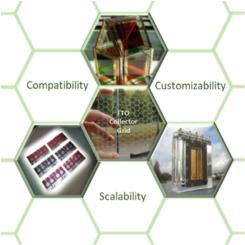Enhancing large-area photoelectrochemical cells' performance through conductivity improvement of customizable FTO collectors grid
IF 7.9
2区 工程技术
Q1 CHEMISTRY, PHYSICAL
引用次数: 0
Abstract
Photoelectrochemical cells, including dye-sensitized solar cells (DSSCs) and water-splitting systems (PEC-WS), offer the significant advantage of directly converting solar energy into electricity and/or fuel. However, their commercial viability is limited by upscaling challenges, particularly due to the reliance on transparent conductive electrodes, which allow for effective visible light transmission and charge collection yet display ohmic losses arising from the electrical resistance across larger dimensions substrates. Identifying an alternative electrode material suitable across PEC technologies has been challenging due to manufacturing requirements and long-term photostability incompatibility.
In this study, we developed and evaluated fluorine-doped tin oxide (FTO)-coated glass substrates integrated with FTO current collectors as an efficient and stable strategy for upscaling PEC devices. Multiphysics simulations were employed to assess various FTO mesh designs, evaluating the impact of collector density and geometry on the conductivity of the FTO substrates. The optimized configurations were implemented on FTO-coated glasses via ultrasonic spray-pyrolysis, with deposition parameters finely tuned. Large-area DSSCs and PEC-WS devices, featuring a photoactive area of 25 cm2, were assembled with FTO-mesh substrates and exhibited a stable operation with best-performing designs, achieving solar energy conversion efficiencies ca. 2.1 and 1.2 times, respectively higher than collector-less DSSC and PEC-WS reference counterparts.

通过提高可定制FTO集电极的电导率来提高大面积光电化学电池的性能
光电化学电池,包括染料敏化太阳能电池(DSSCs)和水分解系统(PEC-WS),提供了直接将太阳能转化为电能和/或燃料的显著优势。然而,它们的商业可行性受到升级挑战的限制,特别是由于依赖透明导电电极,这允许有效的可见光传输和电荷收集,但显示由较大尺寸基板上的电阻引起的欧姆损失。由于制造要求和长期的光稳定性不兼容性,确定适合PEC技术的替代电极材料一直具有挑战性。在这项研究中,我们开发并评估了与FTO集流器集成的氟掺杂氧化锡(FTO)涂层玻璃基板作为升级PEC器件的有效和稳定策略。采用多物理场模拟来评估各种FTO网格设计,评估集电极密度和几何形状对FTO衬底电导率的影响。通过超声喷雾热解对fto镀膜玻璃进行了优化配置,并对沉积参数进行了微调。采用FTO-mesh衬底组装的大面积DSSCs和PEC-WS器件具有25 cm2的光活性面积,并以最佳设计表现出稳定的运行,实现的太阳能转换效率分别是无集热器DSSC和PEC-WS参考器件的2.1倍和1.2倍。
本文章由计算机程序翻译,如有差异,请以英文原文为准。
求助全文
约1分钟内获得全文
求助全文
来源期刊

Journal of Power Sources
工程技术-电化学
CiteScore
16.40
自引率
6.50%
发文量
1249
审稿时长
36 days
期刊介绍:
The Journal of Power Sources is a publication catering to researchers and technologists interested in various aspects of the science, technology, and applications of electrochemical power sources. It covers original research and reviews on primary and secondary batteries, fuel cells, supercapacitors, and photo-electrochemical cells.
Topics considered include the research, development and applications of nanomaterials and novel componentry for these devices. Examples of applications of these electrochemical power sources include:
• Portable electronics
• Electric and Hybrid Electric Vehicles
• Uninterruptible Power Supply (UPS) systems
• Storage of renewable energy
• Satellites and deep space probes
• Boats and ships, drones and aircrafts
• Wearable energy storage systems
 求助内容:
求助内容: 应助结果提醒方式:
应助结果提醒方式:


